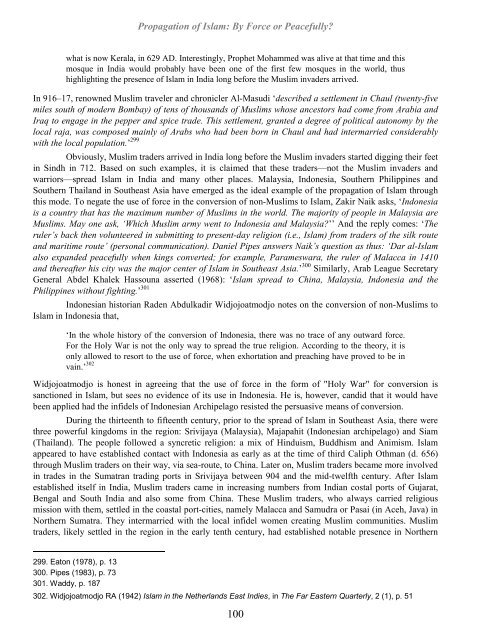islamic-jihad-legacy-of-forced-conversion-imperialism-slavery
islamic-jihad-legacy-of-forced-conversion-imperialism-slavery
islamic-jihad-legacy-of-forced-conversion-imperialism-slavery
- No tags were found...
You also want an ePaper? Increase the reach of your titles
YUMPU automatically turns print PDFs into web optimized ePapers that Google loves.
Propagation <strong>of</strong> Islam: By Force or Peacefully?what is now Kerala, in 629 AD. Interestingly, Prophet Mohammed was alive at that time and thismosque in India would probably have been one <strong>of</strong> the first few mosques in the world, thushighlighting the presence <strong>of</strong> Islam in India long before the Muslim invaders arrived.In 916–17, renowned Muslim traveler and chronicler Al-Masudi ‘described a settlement in Chaul (twenty-fivemiles south <strong>of</strong> modern Bombay) <strong>of</strong> tens <strong>of</strong> thousands <strong>of</strong> Muslims whose ancestors had come from Arabia andIraq to engage in the pepper and spice trade. This settlement, granted a degree <strong>of</strong> political autonomy by thelocal raja, was composed mainly <strong>of</strong> Arabs who had been born in Chaul and had intermarried considerablywith the local population.’ 299Obviously, Muslim traders arrived in India long before the Muslim invaders started digging their feetin Sindh in 712. Based on such examples, it is claimed that these traders—not the Muslim invaders andwarriors—spread Islam in India and many other places. Malaysia, Indonesia, Southern Philippines andSouthern Thailand in Southeast Asia have emerged as the ideal example <strong>of</strong> the propagation <strong>of</strong> Islam throughthis mode. To negate the use <strong>of</strong> force in the <strong>conversion</strong> <strong>of</strong> non-Muslims to Islam, Zakir Naik asks, ‘Indonesiais a country that has the maximum number <strong>of</strong> Muslims in the world. The majority <strong>of</strong> people in Malaysia areMuslims. May one ask, ‘Which Muslim army went to Indonesia and Malaysia?’’ And the reply comes: ‘Theruler’s back then volunteered in submitting to present-day religion (i.e., Islam) from traders <strong>of</strong> the silk routeand maritime route’ (personal communication). Daniel Pipes answers Naik’s question as thus: ‘Dar al-Islamalso expanded peacefully when kings converted; for example, Parameswara, the ruler <strong>of</strong> Malacca in 1410and thereafter his city was the major center <strong>of</strong> Islam in Southeast Asia.’ 300 Similarly, Arab League SecretaryGeneral Abdel Khalek Hassouna asserted (1968): ‘Islam spread to China, Malaysia, Indonesia and thePhilippines without fighting.’ 301Indonesian historian Raden Abdulkadir Widjojoatmodjo notes on the <strong>conversion</strong> <strong>of</strong> non-Muslims toIslam in Indonesia that,‘In the whole history <strong>of</strong> the <strong>conversion</strong> <strong>of</strong> Indonesia, there was no trace <strong>of</strong> any outward force.For the Holy War is not the only way to spread the true religion. According to the theory, it isonly allowed to resort to the use <strong>of</strong> force, when exhortation and preaching have proved to be invain.’ 302Widjojoatmodjo is honest in agreeing that the use <strong>of</strong> force in the form <strong>of</strong> "Holy War" for <strong>conversion</strong> issanctioned in Islam, but sees no evidence <strong>of</strong> its use in Indonesia. He is, however, candid that it would havebeen applied had the infidels <strong>of</strong> Indonesian Archipelago resisted the persuasive means <strong>of</strong> <strong>conversion</strong>.During the thirteenth to fifteenth century, prior to the spread <strong>of</strong> Islam in Southeast Asia, there werethree powerful kingdoms in the region: Srivijaya (Malaysia), Majapahit (Indonesian archipelago) and Siam(Thailand). The people followed a syncretic religion: a mix <strong>of</strong> Hinduism, Buddhism and Animism. Islamappeared to have established contact with Indonesia as early as at the time <strong>of</strong> third Caliph Othman (d. 656)through Muslim traders on their way, via sea-route, to China. Later on, Muslim traders became more involvedin trades in the Sumatran trading ports in Srivijaya between 904 and the mid-twelfth century. After Islamestablished itself in India, Muslim traders came in increasing numbers from Indian costal ports <strong>of</strong> Gujarat,Bengal and South India and also some from China. These Muslim traders, who always carried religiousmission with them, settled in the coastal port-cities, namely Malacca and Samudra or Pasai (in Aceh, Java) inNorthern Sumatra. They intermarried with the local infidel women creating Muslim communities. Muslimtraders, likely settled in the region in the early tenth century, had established notable presence in Northern299. Eaton (1978), p. 13300. Pipes (1983), p. 73301. Waddy, p. 187302. Widjojoatmodjo RA (1942) Islam in the Netherlands East Indies, in The Far Eastern Quarterly, 2 (1), p. 51100


